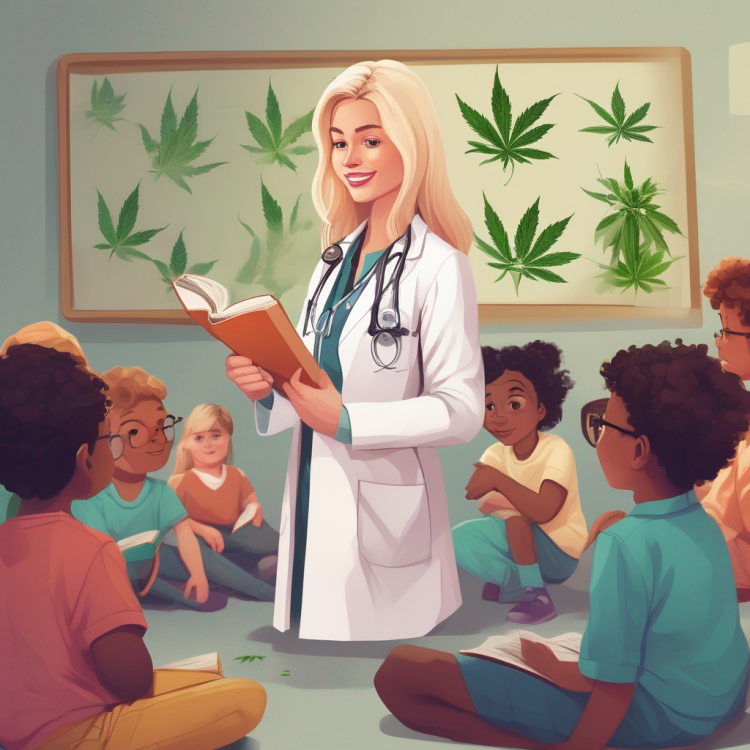
In recent years, medical cannabis has emerged as a versatile treatment option for a wide range of conditions. Its utility in pediatric care has generated significant interest, especially given the anecdotal and research-backed improvements observed in children with various health challenges.
Stories of Children Who Have Taken Medical Cannabis:
- Epilepsy Alleviation: Thousands of children suffering from seizures have seen significant reductions in the frequency and intensity of their epileptic episodes after starting cannabis-based treatments1.
- Autism Spectrum Disorder (ASD) Improvements: There are reports of children with severe ASD experiencing increased sociability, better communication skills, and a decrease in self-harming behaviors after incorporating medical cannabis into their therapeutic regime2.
- Pain Management Breakthroughs: For many children plagued with chronic pain, medical cannabis has transformed their lives, allowing them to partake in standard childhood activities with fewer or no pain-associated setbacks3.
- Attentional Upgrades: Children diagnosed with ADHD have, in some cases, shown increased concentration and decreased hyperactivity when treated with cannabis-based therapies4.
- Cancer-Related Symptom Relief: Pediatric cancer patients, while undergoing conventional treatments, have experienced reduced nausea, vomiting, and an enhanced appetite with the aid of medical cannabis5.
Side Effects of Cannabis for Children:
Most pediatric patients undergoing cannabinoid-based therapies report minimal to no adverse effects. However, a small percentage might experience bouts of excessive laughter, giggling, or display silly behaviors, which generally resolve on their own. Some children may also feel sedated or unusually sleepy. It’s essential to understand that, especially in conditions like Autism, suboptimal doses can occasionally lead to increased hyperactivity6.
Comparing Side Effect Profiles:
| Medication/Therapy | Common Side Effects | Frequency of Side Effects |
|---|---|---|
| Cannabinoids | Sleepiness, Laughter | Rare6 |
| Ibuprofen | Gastric upset | Common7 |
| Tylenol | Liver damage | With overuse8 |
| Corticosteroids | Weight gain, mood swings | Frequent9 |
| Toredol | Gastric bleeding | Common10 |
| Tramadol | Dizziness, nausea | Frequent11 |
| Trazodone | Sedation, dry mouth | Common12 |
| Benzodiazepines | Drowsiness, addiction | Frequent13 |
| Barbiturates | Respiratory depression | With overuse14 |
| Opiates | Constipation, dependence | Common15 |
| Amoxicillin | Diarrhea, rash | Common16 |
| Albuterol | Tremors, palpitations | Frequent17 |
| Cefdinir | Diarrhea, stomach pain | Common18 |
| Prednisolone | Weight gain, high blood pressure | Frequent19 |
| Loratadine | Headache, dry mouth | Uncommon20 |
| Azithromycin | Diarrhea, nausea | Common21 |
| Hydrocortisone | Skin thinning, acne | With prolonged use22 |
| Diphenhydramine | Drowsiness, dry mouth | Common23 |
When to Seek Expertise:
While cannabinoids exhibit a promising therapeutic profile, it’s crucial to acknowledge that every individual responds differently. For specific medical diagnoses and uncertainties, consult a specialist like Dr. Caplan at the CED Clinic to ensure safe and tailored care.
📗 Note: The diagram you see here is based on principles discussed in greater depth in “The Doctor-Approved Cannabis Handbook.” Enhance your knowledge by purchasing the book directly through this link 📗

Footnotes
- Devinsky, O., et al. (2017). “Trial of Cannabidiol for Drug-Resistant Seizures in the Dravet Syndrome.” The New England Journal of Medicine.
- Barchel, D., et al. (2018). “Oral Cannabidiol Use in Children With Autism Spectrum Disorder to Treat Related Symptoms and Co-morbidities.” Frontiers in Pharmacology.
- Kuhathasan, N., et al. (2019). “The use of cannabinoids for sleep: A critical review on clinical trials.” Experimental and Clinical Psychopharmacology.
- Cooper, R.E., et al. (2017). “Cannabinoids in attention-deficit/hyperactivity disorder: A randomised-controlled trial.” European Neuropsychopharmacology.
- Sredni, B., & Albeck, M. (2020). “Cannabis in Pediatric Oncology: To Use or Not to Use?.” Frontiers in Pharmacology.
- MacCallum, C.A., & Russo, E.B. (2018). “Practical considerations in medical cannabis administration and dosing.” European Journal of Internal Medicine.
- Graham, G.G., et al. (2013). “Clinical pharmacokinetics of ibuprofen. The first 30 years.” Clinical Pharmacokinetics.
- Heard, K.J. (2008). “Acetylcysteine for Acetaminophen Poisoning.” The New England Journal of Medicine.
- Buttgereit, F., et al. (2005). “Efficacy of modified-release versus standard prednisone to reduce duration of morning stiffness of the joints in rheumatoid arthritis (CAPRA-1): a double-blind, randomised controlled trial.” The Lancet.
- Sinatra, R. (2010). “The COX-2 inhibitors: a return to the traditional interpretation of the therapeutic pyramid.” Pain Medicine.
- Grond, S., & Sablotzki, A. (2004). “Clinical pharmacology of tramadol.” Clinical Pharmacokinetics.
- Nierenberg, A.A., et al. (1994). “Trazodone for antidepressant-associated insomnia.” The American Journal of Psychiatry.
- Lader, M. (2011). “Benzodiazepines revisited—will we ever learn?.” Addiction.
- Greenblatt, D.J., & Shader, R.I. (1978). “Pharmacokinetics of barbiturates.” Clinical Pharmacokinetics.
- Vowles, K.E., et al. (2015). “Chronic pain, opioid prescriptions, and mortality in Denmark: A population-based cohort study.” Pain.
- Joint Task Force on Practice Parameters. (2010). “Drug allergy: an updated practice parameter.” Annals of Allergy, Asthma & Immunology.
- Cates, C.J., & Cates, M.J. (2008). “Regular treatment with salmeterol for chronic asthma: serious adverse events.” Cochrane Database of Systematic Reviews.
- Karageorgopoulos, D.E., & Falagas, M.E. (2008). “Current control and treatment of multidrug-resistant Acinetobacter baumannii infections.” The Lancet Infectious Diseases.
- Schäcke, H., et al. (2002). “Mechanisms involved in the side effects of glucocorticoids.” Pharmacology & Therapeutics.
- Church, M.K., et al. (2001). “Safety and efficacy of loratadine (Clarityn) syrup as an over-the-counter drug for the treatment of children with allergic rhinitis.” Allergy.
- Gao, Z.W., et al. (2018). “Efficacy and safety of azithromycin injection in community-acquired pneumonia: a randomized controlled trial.” Military Medical Research.
- Hengge, U.R., et al. (2006). “Adverse effects of topical glucocorticosteroids.” Journal of the American Academy of Dermatology.
- Blyden, G.T., et al. (1986). “Diphenhydramine overdose with intraventricular conduction delay treated with sodium bicarbonate.” American Journal of Emergency Medicine.
📗 Note: Diagram’s the warm-up. Ready to run the marathon? Pace yourself with the book. On your mark, get set, go here 📗.
Cannafactoid: In Bhutan, marijuana grows wild and is more common as feed for pigs than for human consumption.



